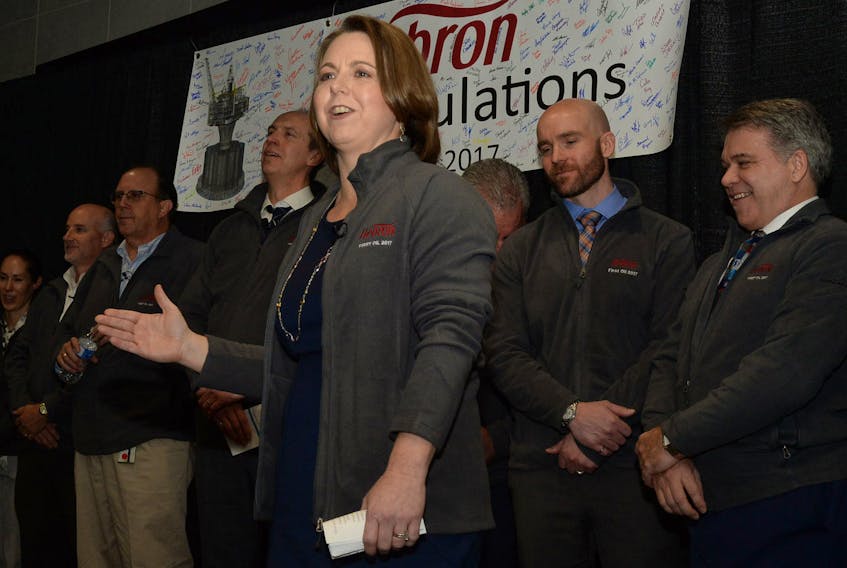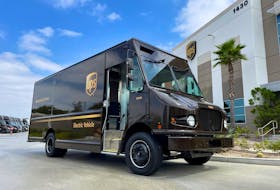The number of offshore oil and gas platforms successfully operating off the coast of Newfoundland climbed to four this week with news that first oil was produced Monday at Hebron.
ExxonMobil Canada president Carman Mullins and vice-president Mike Ryan made a video call to offshore installation manager Paul Dwyer, who confirmed the big news.
“On behalf of ExxonMobil Canada and all the workers here on the Hebron platform, I’m very pleased to announce that as of 11:03 on November 27, the Hebron platform successfully and safely achieved first oil,” Dwyer said.
“This is a very important and impressive milestone. It’s what we came here to do and all of the workers on the platform are very proud to officially share this good news with you.”
That pride was on full display in the lobby of the St. John’s Convention Centre, where a couple hundred employees of ExxonMobil and co-venturers Chevron, Suncor Energy, Statoil, and Nalcor Energy Oil and Gas Inc. gathered to celebrate the achievement.
More than a few of those employees were around for a similar announcement when Hibernia produced its first oil 20 years and 11 days ago.
Jim Flood, ExxonMobil’s vice-president of projects, says the Hebron team learned a lot from Hibernia.
“We have really cherished those memories and learning and applied them to Hebron to try to do a little bit better at the end of the day, and when you think about being able to achieve and deliver a project ahead of schedule, it’s a tremendous achievement,” Flood said.
The plan was to have first oil produced before the end of 2017, but Mullins says the plan didn’t include coinciding with the Hibernia anniversary.
“We want to do safe, reliable start-up and most importantly, through ExxonMobil and our project management systems, we want to deliver on our commitments and our commitment was first oil before year end 2017 and we’re here very excited today to say we’ve done that.”
While they’ve drilled just one well to start toward the peak capacity of 150,000 barrels a day, Hebron’s drill teams will use between 20 and 30 to hit that goal. The Hebron field, located roughly 350 kilometres southeast of St. John’s, is estimated to contain 700 million barrels of Brent crude.
During peak construction, the project employed 7,500 workers in Bull Arm. The day-to-day operations require more than 600 workers onshore and offshore.
Not discounting those benefits and the spinoff economic benefits that will be created throughout the project’s lifespan, it is royalties that will have the most impact on the province’s economy.
Siobhan Coady, Newfoundland and Labrador minister of natural resources, says it will start slow and grow over time.
“It starts off very small because, of course, they’re doing payback on the development and build of the Hebron platform.
“Obviously we want to continue to grow the amount of royalties that come to the province, we want to continue to see more opportunities for the province, but it’ll take some time for the royalties to accrue.
“But you also have to remember that we have an equity stake with Nalcor oil and gas division and that’ll also bring revenues to the province over time.”
How much the province banks in royalty revenues could be strongly influenced by what kind of plan is developed to tackle the carbon tax.
While the federal government has its own ideas, it’s up to the provinces to come with a plan that will be vetted and given the green light in Ottawa.
Coady says the provincial government is working with the federal Liberals and the industry to come up with “a made in Newfoundland and Labrador solution” that works for everyone and recognizes the current and future developments within the industry.
Twitter: kennoliver79









